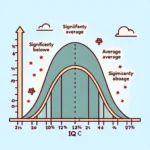Understanding the Bell Curve in IQ Testing
IQ, or intelligence quotient, has long been a measure used to assess an individual’s cognitive abilities in relation to an age-matched population. One of the most notable characteristics associated with IQ testing is its results’ distribution, widely known as the bell curve, or normal distribution. The bell curve plays a pivotal role in understanding how IQ scores are spread across a population, providing valuable insights into the assessment of intelligence.
The bell curve metaphorically represents the statistical distribution of IQ scores in a graphically appealing manner. It’s named for its bell-like shape when plotting the frequency of scores. At the center of the curve is the average IQ score, which is typically set at 100 by design. The vast majority of people, approximately 68 percent, have IQ scores that fall within one standard deviation of the mean – that is, between 85 and 115. This clustering around the average is why the peak of the bell curve is located at the mid-point of the scale.
Moving away from the center, the curve slopes downwards on either side, depicting a decrease in the number of individuals as you move towards higher or lower IQ scores. About 95 percent of the population has an IQ between 70 and 130, falling within two standard deviations of the average. These parameters are generally accepted in standard IQ testing across various cognitive assessment tools. Only a small portion of people have scores significantly above or below this range, which is why the tails of the bell curve taper off to the sides.
Importantly, the bell curve in IQ testing serves several critical functions. For one, it allows psychologists and educators to benchmark an individual’s cognitive abilities against a standardized reference. This comparative analysis is essential for identifying unique educational needs, potential learning disabilities, or exceptionally high cognitive capabilities that may require special attention.
Additionally, the bell curve is instrumental for psychometricians — professionals who specialize in measuring mental capacities and processes — when they are validating IQ tests. By ensuring that test results conform to a bell curve, they can validate that the test is accurately measuring intelligence across a diverse sample of individuals. Tests that do not yield a normal distribution might be biased or flawed, leading to unreliable assessments of intelligence.
Moreover, the bell curve concept extends beyond just individual assessment. It aids in statistical research and the development of public policies relating to education and training programs. Policymakers and researchers use the distribution of intelligence as represented by the bell curve to make informed decisions on resource allocation and the creation of interventions aimed at various groups within the population.
It’s crucial to note, however, that while the bell curve provides a mathematical model for distribution, it is not without controversy when applied to the complexities of human intelligence. There are ethical considerations and potential biases in IQ testing and interpretation that must be taken into account. Intelligence is a multifaceted construct, influenced by a broad array of genetic, environmental, and socio-cultural factors. Consequently, any singular depiction like the bell curve can only provide a simplified snapshot of a much more intricate human attribute.
In conclusion, the bell curve is a fundamental concept in the realm of IQ testing, giving structure to the way intelligence scores are distributed across a population. It supports the interpretation of individual scores and guides the standardization and validation of IQ tests. Despite its widespread utility, the use of the bell curve in understanding human intelligence remains a subject of ongoing debate, reminding us of the complexity inherent in measuring the human mind’s capabilities. Understanding the nuances behind this statistical model is paramount for professionals in the field of psychology and education, as well as for individuals aiming to comprehend the significance of IQ scores.

